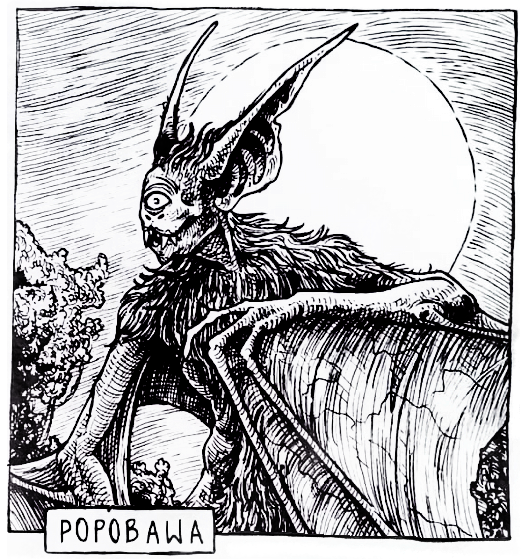
(Illustrated by DK13 DESIGN, 6. 12. 2019.)
جناح الخفافيش
“Such a creature could best an army in the light of day, yet it waits until the dead of night and preys upon men as they dream. It is the nightmare, it yearns to be feared, feared for all eternity.”
—Carvest, The Legends of Eloren, C. M. Johnson
It has long been the belief, among the Makonde people (of the lands now known as southeast Tanzania and northern Mozambique) that otherworldly beings known as the shetani, haunt and plague this world (or more specifically, the humans that inhabit it). The shetani are essentially understood to be evil spirits, very similar to the demons of Judeo-Christian faith. Though with changing cultural influences in the region, they could be more closely related now to the Djinn of Arabic Mythology. Despite being regarded as shapeshifters/skinchangers, they are described as odd anthropomorphic combinations, animals with humanoid features. Quite often cyclopic, disfigured, grotesquely formed creatures. Many of the carvings of shetani depict them with their heads on backwards, exaggerated genitalia, the physical depiction could be interpreted as visual chaos. After all, what is a demon of any cultural conjuration, if not an incarnation of chaos?
While the title of shetani covers a broad range of spirits (most typically considered to be malevolent), there are specific types which behave in unique ways. Some, like the Shuluwele are said to be controlled by sorcerers, similar to the belief of conjured and controlled demons by mortal sorcerers outlined in the ‘The Key of Solomon’ (circa 1300-1400). The Ukunduka however, are a far more troublesome spirit. While many of the shetani feed through various forms of energy absorption, primarily fear, possession of a human host, some suggesting even the consumption of human flesh or blood. The Ukunduka, feed through sexual intercourse with a human. Of all the Ukunduka, of all the shetani, one spirit in particular has earned a reputation which has swept up a frenzy of fear across the south-eastern coast of Africa, for many years.
The Popobawa, considered to be the most evil, dangerous and currently active shetani of Tanzania. It’s often misunderstood that the Popobawa (Popo Swahili for ‘Bat’ and Bawa, ‘Wing’) was named so due to its physical characteristics, but that is likely inaccurate because all shetani can change their physical form at will. The name came about because it was remarked that before a victim experienced an attack, a large dark shadow would form beneath the flying spirit, similar to that cast of large bat wings.
As far as shetani go, the belief in the being called Popobawa is actually quite new, possibly as late as the 1960s. As the common story goes, a sheikh, during a grievance with a neighboring community (possible speculative/perceived Arab resentment toward the community after its liberation and the collapse of the Arab-run slave markets of the Zanzibar archipelago. Slavery continued in the region up until around 1918), he summoned the worst kind of djinn/demon/shetani/spirit he could, to wreak havoc on those that angered him (the current inhabitants of Tanzania and surrounding islands, the first recorded event believed to be Pemba Island, 1965 – one year after the Revolution of Zanzibar. Fear, change and instability seem to be a breeding ground for hysteria. Similarly mentioned in ᵀᴴᴱ LAUGHING MADNESS ᴏғ TANGANYIKA ₁₉₆₂). Consequently, the sheikh could not control the spirit and it has been preying on its victims across Tanzania ever since.
Interestingly, just like the Judeo-Christian affiliation of demons and hell with the smell of burnt sulfur, that smell is also said to arise with the presence of the Popobawa. While the Popobawa is feared for causing poltergeist-like activity, nightmares, physical attacks, it is most notorious for sodomizing its victims (men, women and children. Though reports of sodomy are disproportionately adult male victims).
In 1971, villagers of Pemba Island reported witnessing a possession (very similar to the demonic possessions described in Catholicism), where a young girl identified only as Fatuma spoke in a deep adult male voice. Whether this incident was later connected to the Popobawa, or what the girl actually said, (to my understanding) is not documented. At the time, belief in exorcisms, general superstition and apotropaic (magically protective) practices were quite high. The use of talismans, religious icons, sacrificial goats to keep evil at bay were/are relatively common.
Although the first reports were believed to have arisen in 1965, again in the 70’s and 80’s, the most resounding event occurred on the Island of Pemba, in 1995 (though reports of Popobawa encounters seem to loosely correlate with elections and times of uncertainty. Most victims refute there is a connection, though it has also been suggested that summoners “aggravate” the Popobawa, causing spikes in encounters).
Pandemonium ensued across the Zanzibar archipelago, specifically upon the Tanzanian island of Pemba, in 1995. An influx of reports began to arise, of visitations of the Popobawa, most frequently during the dead of night. Many victims, mostly men reported an evil spirit visiting them in the night, much like the concept of the incubus/succubus. The shadowy creature sodomizes its victims, while they remain paralyzed (very similar to experiences described by victims of Sleep Paralysis Disorder).
Similarly to Sleep Paralysis, where someone is far more likely to experience it after being told about it (one of the main topics of a book I wrote called, ᴀ COMPENDIUM ᴏғ FEAR: ᴀʙᴏʟɪsʜ ᴛʜᴇ ᴅᴇᴍᴏɴ), it is also a trait of the Popobawa to demand its victims tell others. It is commonly believed that if you tell as many others as you can of the Popobawa’s existence, it will lessen its affliction over you and move on to another victim (no, that isn’t the reason for writing this). To deny its existence, enrages the creature. Many residents of Pemba Island, 1995, refused to sleep in their beds, believing the creature favored those who slept indoors. They would stand outside and keep fires burning the night through, fearful to fall asleep, highly reminiscent of the plot of the film, ‘A Nightmare on Elm Street’, 1984.
Some victims of the Popobawa, claiming to have been sexually assaulted during the night have claimed physical wounds remain after attacks, along with physical evidence of sexual intercourse, seminal and ectoplasmic fluids. However, no Doctor in Tanzania or the islands of the Zanzibar archipelago have ever come forward to say they examined a single victim of a Popobawa attack.
Could this creature, these events, this fear be simply sleep paralysis disorder enveloped in mass hysteria? Hypnopompic hallucinations, the kind we experience as we regain consciousness from a sleep state. Could it be a hypnagogic hallucination, the kind we experience as we lose consciousness? For as long as human beings have recorded history, recorded their dreams, their fears, the concept of the incubi, the succubi has been with us, since the dawn of time. “Old Hag” syndrome, demonic affliction toward a paralyzed victim, is it human nature to perpetually conjure this sort of nocturnal torture upon ourselves?
Or does the torture come from somewhere/someone/something else?

Fascinating read. Didn’t know you had a book – just purchased it. Looking forward to reading Compendium of Fear.
LikeLiked by 1 person
Thanks Andrew, I really appreciate that. And thanks so much for purchasing a copy of my book. At the time of writing it I was corresponding with several people in different parts of the world experiencing what they believed to be supernatural afflictions. So I was sort of compiling notes on different subjects and reflecting on commonalities of what I was being told (along with personal experience). Eventually realizing the greatest commonality of all, regarding these events, seemed to be fear. Knowing the kind of topics you cover, the things discussed in this book would be right up your alley. However, I should say the translation of notes, facts, quotes and opinions does make it quite a cumbersome read. Hopefully some of the topics will pique your interest though.
LikeLike